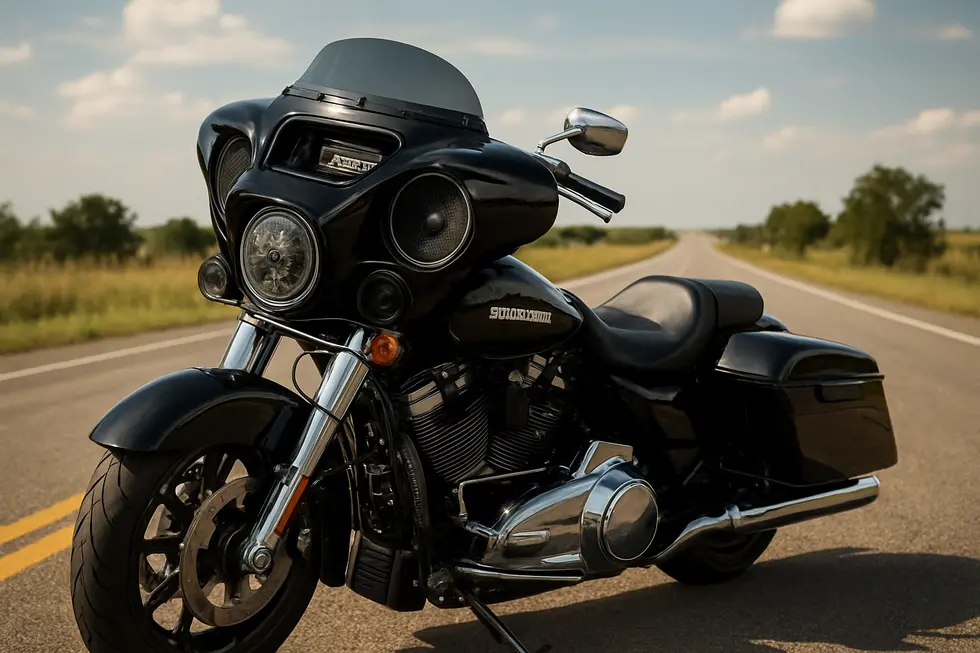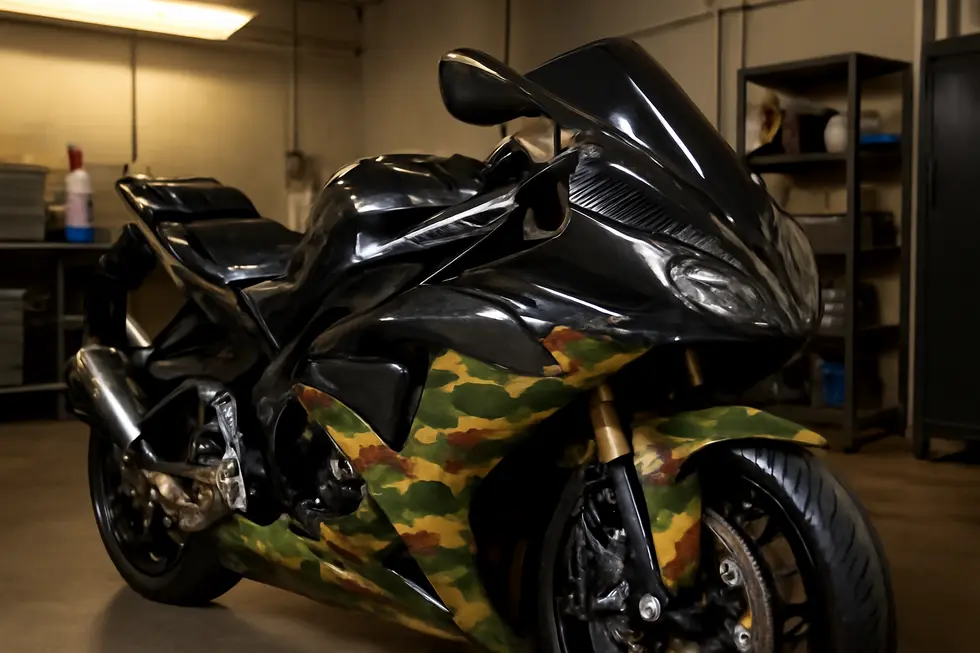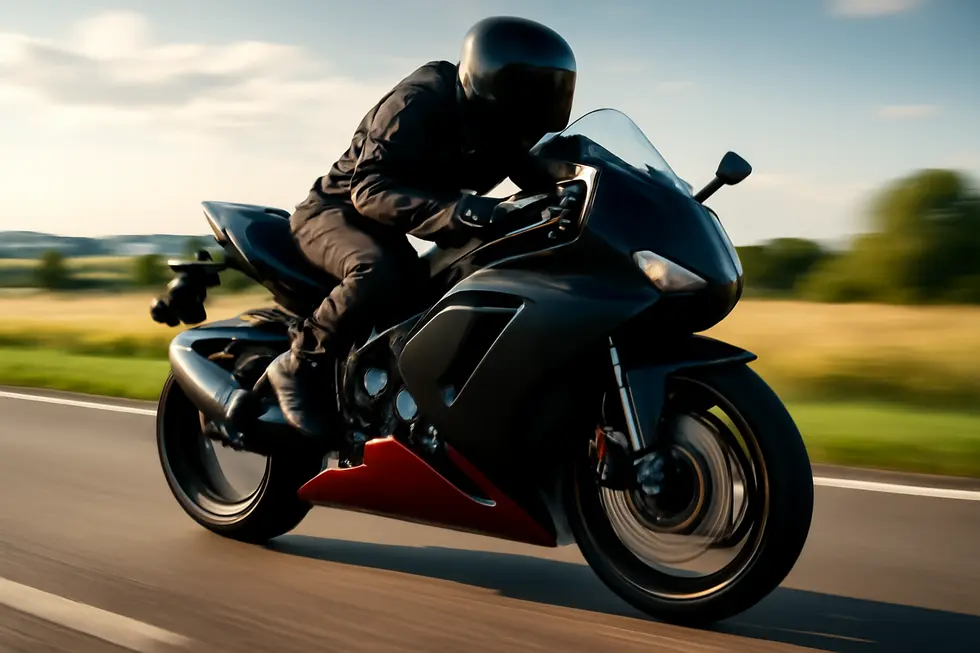Understanding Motorcycle Fairings: Enhancing Performance and Rider Experience
August 17, 2025 | by summitfairings
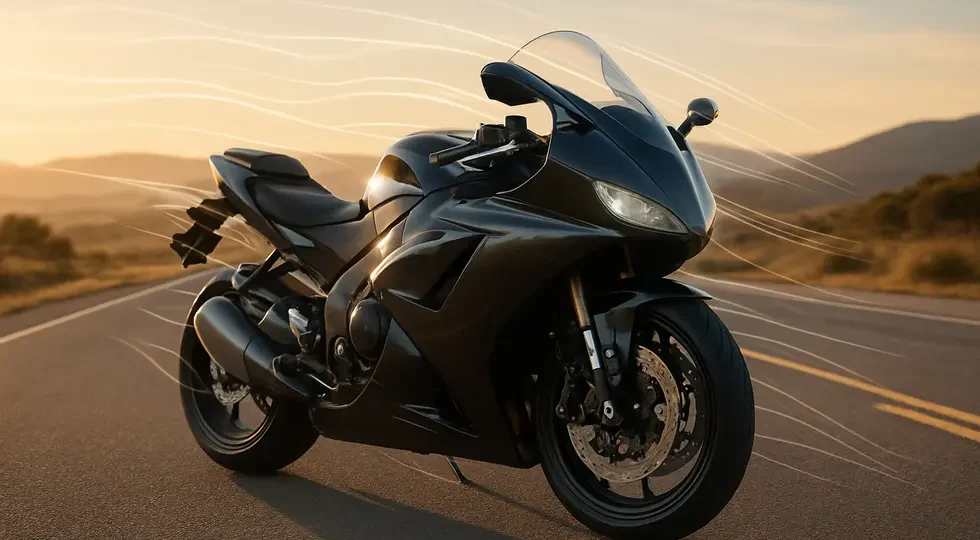
Introduction
Motorcycle fairings are more than just aesthetic enhancements; they serve crucial functional roles that affect a bike’s aerodynamics, performance, and rider comfort. For business owners in the motorcycle industry, understanding the nuances of fairings can unlock opportunities to improve product offerings, enhance customer satisfaction, and capitalize on performance-driven aftermarket parts. This insight into what fairings are and how they work provides a foundation for smarter inventory decisions and better-informed customer advice. The first chapter details the various types of fairings and their aerodynamic roles, followed by an exploration of how these components affect motorcycle performance and rider comfort. The final chapter addresses the importance of model-specific design and applications, underscoring the need for precision to maximize benefits. Together, these perspectives present a comprehensive overview that equips business owners with the knowledge to support and grow their market presence.
Tables of Contents
Chapter 1: Types of Fairings on a Motorcycle and Their Role in Aerodynamics
- Full Fairings: Unrivaled Aerodynamic Mastery and Protective Coverage for High-Speed Performance
- Half Fairings: The Practical Blend of Aerodynamics and Accessibility
- Quarter Fairings: Streamlined Minimalism for Targeted Wind Protection and Aerodynamic Ease
- Naked Motorcycles: Embracing Simplicity While Trading Off Aerodynamic Efficiency
- Aero Appendages in Motorcycle Fairings: Boosting Racing Stability and Control through Downforce
Chapter 2: Impact of Fairings on Motorcycle Performance and Rider Comfort
- How Motorcycle Fairings Streamline Aerodynamics to Elevate Performance and Comfort
- Enhancing Rider Protection and Comfort Through Advanced Fairing Design
- How Motorcycle Fairings Influence Stability and Traction through Aerodynamic Control
- Balancing Added Weight and Aerodynamic Benefits: How Fairings Shape Performance and Rider Experience
- Preserving Performance and Comfort: Essential Maintenance and Safety Practices for Motorcycle Fairings
Chapter 3: Model Specificity and Application of Fairings on a Motorcycle
- Precision Fit: How Model-Specific Fairings Transform Motorcycle Performance and Installation
- How Model-Specific Fairings Enhance Aerodynamics and Rider Protection
- Evolving Styles and Tailored Designs: Customization Trends in Model-Specific Motorcycle Fairings
- How Motorcycle Types Shape the Design and Function of Model-Specific Fairings
- Essential Components and Installation Nuances Behind Model-Specific Motorcycle Fairing Kits
Chapter 1: Types of Fairings on a Motorcycle and Their Role in Aerodynamics
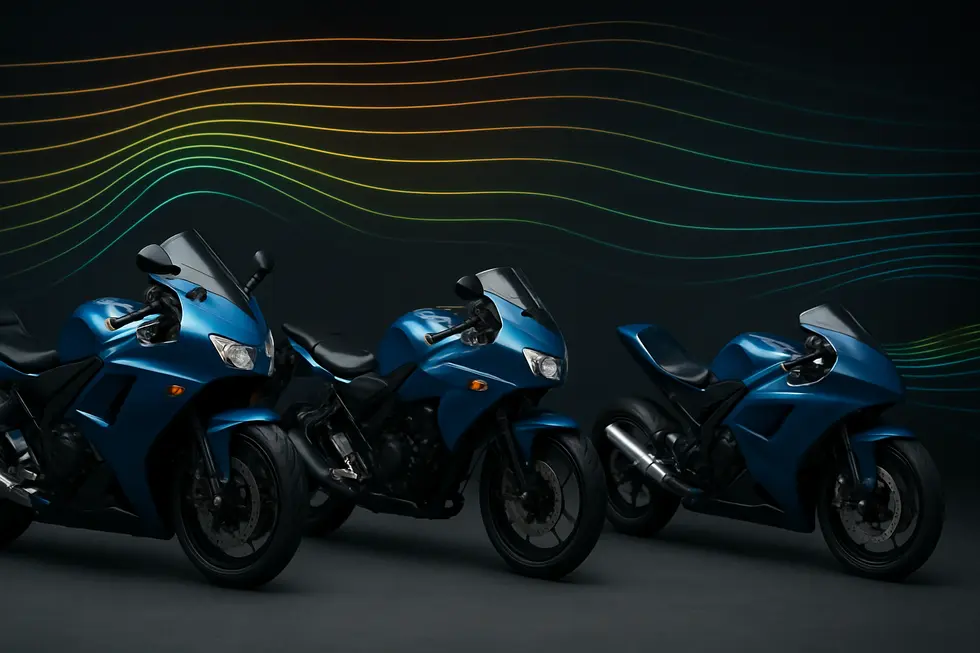
1. Full Fairings: Unrivaled Aerodynamic Mastery and Protective Coverage for High-Speed Performance
Full fairings are the most extensive type of aerodynamic bodywork on motorcycles, enveloping the front, sides, and often the lower belly of the bike. Their primary function is to dramatically reduce air resistance by streamlining airflow around the motorcycle and rider. This comprehensive coverage minimizes turbulence and drag, which in turn boosts top speed, stability, and acceleration. By shaping the air as it flows, full fairings generate measurable downforce, pressing tires firmly onto the road for enhanced traction and improved control—especially critical during rapid cornering and high-speed straight runs.
The design also shields the rider from harsh wind buffeting and weather elements, significantly reducing fatigue on longer rides. This balance of aerodynamic efficiency and comfort is why full fairings dominate sport and racing motorcycles, where performance gains and rider endurance are paramount. However, the extensive coverage can sometimes slightly restrict handlebar or fork movement, making maneuverability a design consideration.
Traditionally associated with iconic sportbike silhouettes, full fairings have evolved to integrate advanced aerodynamic features such as winglets or spoilers. These additions elevate downforce further, stabilizing the bike under extreme speeds without sacrificing efficiency. This evolution highlights the ongoing role of full fairings not only as protective shells but as precision-engineered components that directly influence handling dynamics and rider confidence.
For motorcycles originally built without wind protection, adding full fairings transforms their performance and comfort by introducing the aerodynamic benefits typically reserved for racing machines. Exploring options at a dedicated source for aerodynamic solutions can offer insights into choosing fairings best suited for your riding style and motorcycle frame.
For a detailed explanation of full fairings and their aerodynamic role, see the video by The Racing Xpert from August 2025.
Learn more about a wide selection of motorcycle fairings at Summit Fairings.
2. Half Fairings: The Practical Blend of Aerodynamics and Accessibility
Half fairings occupy a unique space in motorcycle design, offering a thoughtful compromise between aerodynamic benefit and practical usability. Unlike full fairings that wrap around the engine and frame, half fairings cover only the upper front section of the motorcycle, including the windshield, headlights, handlebars, and the instrument panel. This selective coverage reduces frontal drag and eases airflow around the rider’s torso and head, thereby improving ride stability and reducing wind fatigue without excessively encasing the bike.
Aerodynamically, half fairings provide moderate reductions in air resistance, helping to smooth airflow in a way that enhances both speed and control. The reduced drag translates into better acceleration and steadier handling at highway speeds, making half fairings an ideal feature for sport and mid-range performance motorcycles. Crucially, their design preserves much of the naked bike’s agility, as the lighter weight and smaller surface area avoid the bulkiness associated with full fairings, which can sometimes hinder quick maneuvers.
From a maintenance perspective, half fairings simplify access to the engine and mechanical parts. Riders and mechanics benefit from the ability to perform repairs and adjustments without removing extensive bodywork, a convenience not offered by full fairings. This accessibility coupled with reasonable wind protection makes half fairings a favored choice among riders desiring both functional performance and everyday practicality.
Ultimately, half fairings strike a balance that supports spirited riding styles while offering enough aerodynamic refinement to reduce rider strain on longer journeys. Their thoughtful design aligns with the needs of riders who prioritize a mix of comfort, speed, and hands-on maintenance. For those exploring varied fairing options, a detailed exploration of motorcycle fairings sheds further light on models and applications.
3. Quarter Fairings: Streamlined Minimalism for Targeted Wind Protection and Aerodynamic Ease
Quarter fairings represent a minimalist approach to motorcycle aerodynamics, focusing primarily on the area around the headlight. Unlike full or half fairings that envelop significant portions of the bike to optimize airflow and reduce drag, quarter fairings offer a subtle aerodynamic benefit without the added bulk or weight. Their streamlined design gently redirects air around the rider’s upper torso and head, diminishing wind buffeting and decreasing rider fatigue during moderate to high-speed travel.
This focused coverage preserves the motorcycle’s agile handling and classic aesthetic, making quarter fairings an attractive choice for riders seeking a balance between wind protection and maneuverability. Although they do not deliver the extensive drag reduction or downforce advantages associated with larger fairings, quarter fairings provide a meaningful compromise. By minimizing frontal turbulence near the rider’s helmet, they improve comfort and modestly enhance aerodynamic efficiency without compromising the bike’s natural feel.
Furthermore, quarter fairings are often favored in custom builds or on naked bikes that lack any aerodynamic coverings. They enhance wind deflection in a targeted manner, mitigating some of the raw wind exposure inherent to these models, while maintaining a clean, minimalist profile. Because they attach around the headlight area only, their installation is simpler and more adaptable to various motorcycle geometries compared to full or half fairings.
For riders who prioritize agility and stylistic simplicity but still desire basic wind protection and aerodynamic refinement, quarter fairings offer an elegant solution. Their subtle impact on airflow makes them a practical middle ground in the spectrum of fairing options. More information about different fairing styles and choices can be explored at Summit Fairings.
Reference: https://www.youtube.com/watch?v=N1hCF0cbMzY
4. Naked Motorcycles: Embracing Simplicity While Trading Off Aerodynamic Efficiency
Naked motorcycles stand apart in their deliberate omission of fairings, the aerodynamic body panels that streamline airflow and boost stability at high speeds. This absence reflects a design philosophy rooted in simplicity, ease of maintenance, and an aggressive aesthetic rather than peak aerodynamic efficiency. Without the smooth contours provided by full or partial fairings, naked bikes expose the rider and mechanical components directly to air currents, resulting in increased drag and turbulence compared to faired motorcycles.
Fairings contribute significantly to reducing wind resistance by shaping airflow to minimize turbulence, which improves acceleration, top speed, and fuel efficiency. They also generate downforce on some models, enhancing traction and cornering stability. Furthermore, fairings protect vital engine parts and help shield riders from wind buffeting, reducing fatigue during longer rides.
Naked motorcycles forgo these aerodynamic advantages to maintain a minimalistic and lightweight structure. This trade-off prioritizes straightforward mechanical access and a raw riding feel, often appealing to riders seeking a more visceral connection with the bike and road. While the lack of bodywork decreases overall aerodynamic performance, it also means fewer complex mounting points and less vulnerability to damage from crashes or debris.
Adding fairings to a naked bike can dramatically improve its aerodynamic profile, enhancing speed and rider comfort by deflecting wind efficiently. However, this comes at the cost of added weight, complexity, and altered styling. The choice between naked and faired designs ultimately depends on the rider’s priorities—whether they favor minimalism and simplicity or the aerodynamic benefits vital for high-speed riding.
For a deeper exploration of various fairing types and their aerodynamic impacts across motorcycle styles, discover affordable motorcycle fairings offers valuable insights.
(Reference: [5])
5. Aero Appendages in Motorcycle Fairings: Boosting Racing Stability and Control through Downforce
Motorcycle fairings, beyond shaping airflow to reduce drag, often integrate specialized aero appendages that critically enhance racing performance by generating downforce and stability. These appendages, such as winglets and extended fairing edges, apply vertical loads that press the bike onto the track, which improves traction during hard acceleration, braking, and cornering. The creation of downforce counters the natural tendency of the front wheel to lift at high speeds, limiting wheelies and increasing front-end grip for superior handling precision.
Strategically positioned on the upper front and side fairings, these components are carefully designed to balance aerodynamic efficiency with maneuverability. By smoothing airflow and adding controlled instability reduction, they help riders maintain better control without sacrificing agility when changing directions. This aerodynamic tuning allows race motorcycles to achieve higher speeds while improving stability during rapid deceleration or sharp bends.
However, racing authorities have introduced regulations to limit the size and shape of these appendages, aiming to maintain safety and competitive parity. For example, MotoGP rules effective from 2027 reduce front fairing width and move certain aerodynamic elements rearward, curbing excessive front tire downforce to ensure riders retain adequate control without overreliance on aerodynamics.
The interplay between full race fairings and aero appendages represents the pinnacle of motorcycle aerodynamic design, combining maximal drag reduction with purposeful downforce generation. While full fairings envelop and streamline most of the bike for top speed, the integrated winglets and extensions actively enhance contact and stability on the track. In contrast, half or quarter fairings lack these advanced aerodynamic aids, making them less optimized for extreme performance but often more versatile for everyday riding.
Understanding these aerodynamic enhancements reveals how modern racing motorcycles harness fairing design not just for speed, but for crucial stability and traction advantages under demanding conditions.
For deeper insights on comprehensive fairing options and their aerodynamic benefits, see this explore the best motorcycle fairings at Summit Fairings.
More about MotoGP aero regulations can be found at Motorsport Magazine: motorsportmagazine.com.
Chapter 2: Impact of Fairings on Motorcycle Performance and Rider Comfort

1. How Motorcycle Fairings Streamline Aerodynamics to Elevate Performance and Comfort
Motorcycle fairings play a vital role in shaping airflow around a bike, significantly boosting both performance and rider comfort. By reducing aerodynamic drag, fairings allow the engine to push the motorcycle to higher speeds with less effort. For instance, advanced fairing designs have been shown to cut drag by several percentage points, which directly translates into improved top speed and fuel efficiency.
Beyond speed, fairings enhance stability by managing airflow to counteract crosswinds and create beneficial downforce. Features like winglets integrated into fairings help press the tires firmly onto the road, aiding grip during acceleration, braking, and cornering. This precision in airflow not only steadies the bike but also reduces dangerous phenomena such as wheel lift at high speeds, contributing to safer handling.
The fairing’s shape and placement also influence how agile the motorcycle feels. Subtle design adaptations, such as adjusting the leading edges of the fairing, can make steering more responsive without compromising aerodynamic benefits. Moreover, certain fairing configurations improve cooling by directing air efficiently toward radiators and oil coolers, preventing overheating during demanding rides.
For the rider, fairings create a smoother, calmer zone of air that reduces wind blast and buffeting. This protective bubble lessens fatigue and physical strain on the upper body, even over long distances or at high speeds. Noise caused by turbulent airflow is also diminished, enhancing comfort.
Different types of fairings strike different balances. Full race fairings deliver maximum aerodynamic gains and protection but can complicate maintenance due to their extensive coverage. Half fairings offer moderate drag reduction and rider shielding while making engine access easier.
Ultimately, fairings optimize airflow to improve motorcycle speed, stability, and rider endurance, blending engineering precision with practical benefits. For a detailed look at diverse fairing options, explore the best motorcycle fairings available and their impact on performance and comfort.
Reference: [1] and [2]
2. Enhancing Rider Protection and Comfort Through Advanced Fairing Design
Motorcycle fairings play a pivotal role in enhancing rider protection and comfort by expertly managing airflow around the bike and rider. Full fairings envelop the motorcycle’s front and sides, significantly diminishing wind buffeting and turbulence that can impact the rider’s head and torso. This reduction in aerodynamic disturbance translates to a more stable and less tiring ride, especially at higher speeds where wind pressure is substantial. Beyond wind deflection, the aerodynamic shaping of fairings can also generate downforce, which improves traction and handling during rapid acceleration or tight cornering, directly benefiting both performance and rider safety.
Comfort is further elevated through integrated features like adjustable windshield systems that allow riders to tailor airflow to their preferences. By fine-tuning the windshield’s height and angle, riders can minimize wind noise and turbulence, effectively enabling them to see over rather than through the shield. This innovation has a profound impact on long-distance rides and highway travel, reducing fatigue and maintaining rider focus. Additionally, fairings form a physical barrier against environmental elements such as small debris, insects, and cold air, preventing distraction and discomfort.
While the benefits of full fairings in protecting and comforting riders are clear, designers must balance these gains against potential restrictions on handlebar or fork movement, which could affect maneuverability. Proper engineering ensures that protection and comfort enhancements coexist with responsive handling.
By harmonizing aerodynamic efficiency with rider-centric features, fairings significantly elevate the motorcycle experience, making rides smoother, safer, and more enjoyable. This synergy of function and comfort highlights the critical influence of fairings, as detailed in resources on superior motorcycle fairings that combine style and utility seamlessly. For deeper insights, explore affordable motorcycle fairings at Summit Fairings.
External reference: [1]
3. How Motorcycle Fairings Influence Stability and Traction through Aerodynamic Control
Motorcycle fairings play a pivotal role in enhancing stability by skillfully managing airflow to reduce aerodynamic drag and turbulence around the bike. This smoother passage of air lessens the harsh wind buffeting that riders face, allowing for steadier control during acceleration, braking, and cornering. While fairings themselves do not directly change tire traction, their contribution to a stable aerodynamic environment supports more precise rider inputs, which is critical for maintaining optimal tire contact with the road.
Full and half fairings streamline the bike’s profile, helping to minimize the disruptive forces that can unsettle it at high speeds. However, extensive side fairings may also have a trade-off: they can catch crosswinds more readily, potentially pushing the motorcycle off its intended path if riders are unprepared. This phenomenon illustrates the delicate balance fairings must achieve between shielding riders and exposing the bike to lateral wind forces.
Traction is fundamentally upheld by the suspension system, which ensures tires maintain firm contact with road irregularities and bumps. The fairings’ indirect support through aerodynamic stability and wind protection reduces rider fatigue, allowing better focus to react appropriately and maintain grip on variable surfaces. In essence, a well-designed fairing setup complements suspension performance by creating a more consistent and protected riding experience.
Thus, the integration of aerodynamic fairings not only refines stability but also fosters conditions where traction can be maximized through rider technique and mechanical setup. For deeper exploration on how suspension systems anchor traction alongside aerodynamic aids, this resource offers valuable insights: motorcycle suspension systems.
For riders considering fairings, understanding these nuanced effects aids in optimizing both comfort and control under varied riding conditions.
4. Balancing Added Weight and Aerodynamic Benefits: How Fairings Shape Performance and Rider Experience
Adding fairings to a motorcycle presents a nuanced balance between the increased weight they introduce and the aerodynamic advantages they provide. While fairings inevitably add mass through additional body panels and mounting hardware, this weight increase can affect key aspects of handling such as agility, acceleration, and braking responsiveness. Heavier fairings may slightly reduce a motorcycle’s nimbleness, particularly in tight maneuvers or quick direction changes. However, this weight penalty is often offset by the significant reduction in aerodynamic drag fairings afford, especially at higher speeds.
Aerodynamics plays a crucial role in not only enhancing top-end speed but also stabilizing the bike by smoothing airflow around both the motorcycle and rider. This results in less wind resistance and turbulence, which improves high-speed stability and reduces rider fatigue caused by constant wind pressure on the torso and helmet. To minimize negative handling impacts, manufacturers increasingly use lightweight materials such as carbon fiber for fairings, which offer structural strength without excessive bulk.
The design of the mounting system, or fairing stays, is equally important. These must secure the fairings to the frame firmly to prevent vibrations or shake that could disrupt control or comfort at speed. Poorly supported panels can lead to distracting flutter or buffeting, detracting from the benefits fairings are meant to provide.
From the rider’s perspective, well-engineered fairings significantly enhance comfort by deflecting windblast and reducing noise. However, if the fairing shape or windshield is not optimally designed, turbulent air can hit the helmet, causing buffeting that increases fatigue rather than relieving it. Therefore, achieving an ideal balance of fairing size, shape, and material is essential in maximizing the positive impact on both motorcycle performance and rider endurance.
For those interested in exploring a wide range of fairings that address these performance and comfort dynamics, resources that focus on aerodynamic design and quality materials can provide valuable insights. More information can be found at Explore the Best Motorcycle Fairings at Summit Fairings.
5. Preserving Performance and Comfort: Essential Maintenance and Safety Practices for Motorcycle Fairings
Motorcycle fairings play a crucial role in enhancing aerodynamic efficiency and rider comfort by reducing wind resistance and shielding against debris. However, their effectiveness depends heavily on proper maintenance and safety considerations that ensure they remain structurally sound and well-mounted. Fairings must be securely fixed using dedicated supports like fairing stays, which stabilize the bodywork against vibrations and forces encountered at high speeds. Loose or damaged mounts not only create distracting noise but can also disrupt airflow and negatively impact handling, risking rider safety.
Regular inspection is vital to detect cracks, warping, or damaged brackets early. Any such defects compromise aerodynamic benefits and expose the rider to the elements. Cleaning fairings should be done gently with mild soaps and soft cloths to protect painted or acrylic surfaces from scratches and chemical deterioration, preserving both aesthetics and function over time. Additionally, the added weight and altered balance from fairings require careful consideration—unsecure or ill-fitted components may affect the motorcycle’s handling dynamics.
In racing or performance scenarios, some fairing mounts are designed for quick removal, facilitating easier servicing without sacrificing stability or safety during rides. For everyday riders, maintaining the integrity of these panels directly translates into sustained comfort by effectively deflecting wind away from the rider’s torso and head, reducing fatigue on longer journeys. Some designs also enhance the pillion passenger’s experience by integrating supportive backrests.
Overall, diligent upkeep—focused on secure mounting, careful cleaning, and timely repairs or replacements—ensures fairings continue to deliver their performance and comfort advantages safely. For further insights on fairing mounting structures and maintenance methods, visit this comprehensive resource on motorcycle fairings.
Chapter 3: Model Specificity and Application of Fairings on a Motorcycle
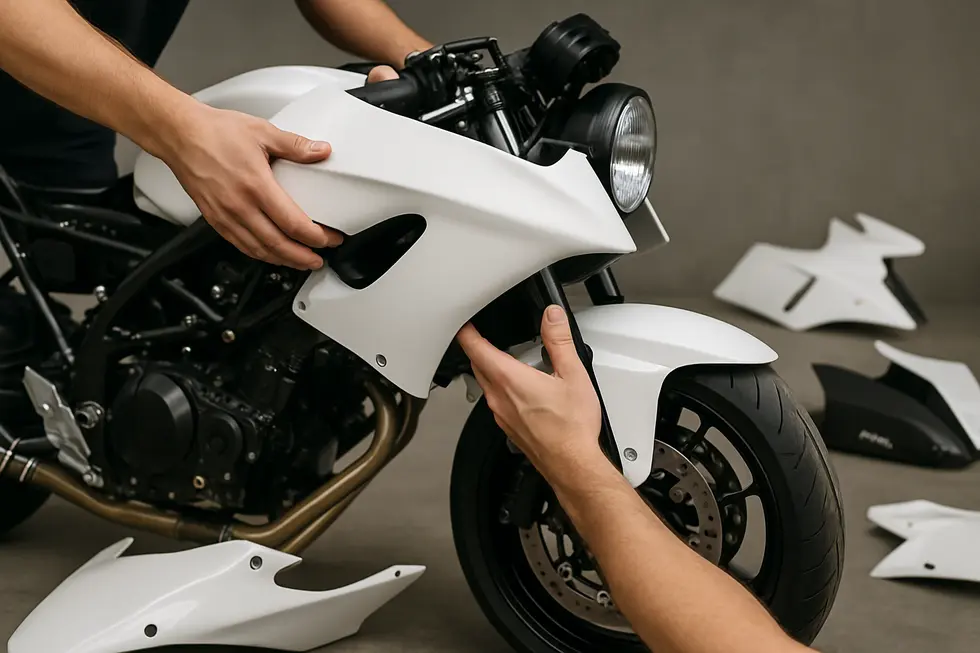
1. Precision Fit: How Model-Specific Fairings Transform Motorcycle Performance and Installation
Model-specific fairings represent a tailored approach to motorcycle bodywork, designed to fit the exact contours and mounting points of a particular bike model. Unlike universal fairings, which often require extensive modifications or additional mounting hardware, model-specific fairings come pre-engineered to align perfectly with a motorcycle’s frame and components. This precision fit facilitates a bolt-on installation process, eliminating the need for special tools or custom adjustments, and ensures that the fairing integrates seamlessly both functionally and aesthetically.
These fairings are typically manufactured with premium materials such as injection-molded ABS plastics or durable fiber-reinforced polymers, shaped precisely to the individual model’s geometry. This not only guarantees a snug, vibration-resistant attachment that enhances high-speed stability but also reduces ride fatigue by maintaining consistent wind deflection. Many model-specific kits come complete with matching paint finishes and all necessary hardware—brackets, bolts, and pre-drilled holes—to preserve the original style and streamline the installation.
A clear distinction emerges when comparing the ease of installation and ride quality of model-specific fairings with universal options. Universal designs may offer broader compatibility at lower price points but frequently demand trial-and-error fitting, resulting in increased vibrations or compromised aerodynamic performance. In contrast, model-specific fairings optimize the balance between form and function, contributing to improved wind resistance and rider comfort without detracting from the motorcycle’s structural integrity.
By focusing on exact fitment and functional integration, these fairings not only refine the bike’s aesthetics but also deliver tangible enhancements in aerodynamics and rider protection. This synergy of precision engineering and practical design underscores why model specificity remains crucial for serious riders seeking both performance and style. For further insights on fairing options and installation best practices, explore detailed resources at Summit Fairings.
2. How Model-Specific Fairings Enhance Aerodynamics and Rider Protection
Motorcycle fairings are more than aesthetic enhancements; they represent precisely engineered components tailored to the unique geometry and purpose of each bike model. Their aerodynamic benefits arise from their ability to streamline airflow, reducing drag and smoothing turbulence that naturally occurs around exposed parts. This carefully sculpted bodywork stabilizes the motorcycle at speed, enhancing handling and enabling higher acceleration and improved fuel efficiency. For racing motorcycles, model-specific fairings go a step further by incorporating advanced aerodynamic features such as winglets, which generate crucial downforce, increasing tire grip and stability during high-speed cornering and braking.
Beyond performance, fairings provide vital protection not only for riders but also for the bike’s mechanical parts. By deflecting wind, debris, and even minor impacts, these coverings reduce rider fatigue and lower the risk of component damage. The protection they offer is optimized when the fairings fit the motorcycle’s frame precisely; this model specificity ensures there are no gaps or loose areas that would compromise aerodynamic efficiency or allow unwanted exposure to elements.
This precision fitting is especially important when adding fairings to naked bikes. These motorcycles typically lack wind protection and have a higher aerodynamic drag profile. Installing fairings designed specifically for the bike’s frame can significantly tame airflow disruptions, boost top speeds, and improve overall ride comfort.
Material choice also plays a critical role in maximizing the benefits. Lightweight composites like carbon fiber keep the fairings strong yet light, preserving agility while supporting aerodynamic shapes and rider shielding.
In summary, fairings tailored to specific models marry form and function brilliantly, enhancing stability, speed, and protection in ways generic parts cannot. For more on choosing the right fairings suited to your motorcycle model, explore this comprehensive guide on discovering unmatched choices in motorcycle fairings.
For further details and visual explanations of aerodynamic features and model-specific fairing applications, refer to this informative video resource: https://www.youtube.com/watch?v=HO5gYgTOCDI
3. Evolving Styles and Tailored Designs: Customization Trends in Model-Specific Motorcycle Fairings
Styling and customization in motorcycle fairings have evolved into an art form deeply connected to model-specific precision and rider personality. The modern rider seeks not only aerodynamic advantages but also a statement of individuality that respects the unique frame geometry and functional demands of their motorcycle. Manufacturers and custom builders now emphasize fitment accuracy with materials like lightweight ABS plastic, molded for seamless integration on models such as the BMW S1000RR or Yamaha MT-09. This tailored approach ensures both practical protection and a sleek, cohesive profile that enhances the motorcycle’s overall silhouette.
Visual trends range from subtle to striking, reflecting diverse rider tastes. Textured finishes that mimic carbon fiber offer a low-key yet premium appearance. These appeal to riders desiring durability and style without overwhelming flash. In contrast, bold geometric vinyl patterns with contrasting colors—black paired with bright orange, for instance—bring a race-inspired, futuristic flair that captures attention on urban streets or stunt events. These design kits often arrive ready-to-install, providing affordable yet impactful customization.
For adventure and off-road enthusiasts, handcrafted aluminum side fairings and rally towers add both rugged aesthetic and practical upgrades like improved crash protection and suspension coverage. Custom builds inspired by military motifs and matte finishes create a unique, commanding presence. Such themes often intertwine paint, exhaust, and ergonomic enhancements, showcasing the potential of fairings as more than just aerodynamics, but as defining elements of a motorcycle’s character.
The customization market is robust and expanding, driven by riders seeking to personalize their machines for expression and functionality amid growing interest in adventure and performance riding. This results in a rich array of options—from everyday commuter upgrades to extreme custom projects—that align perfectly with the specificity of each motorcycle model.
For those exploring diverse, perfectly fitting fairing options and designs, discover affordable motorcycle fairings at Summit Fairings offers a comprehensive perspective and selections that showcase the synergy of styling and fitment.
Model-specific customization cements fairings as a vital nexus of form and function, where aerodynamic efficiency meets personal style tailored precisely to each motorcycle’s character.
4. How Motorcycle Types Shape the Design and Function of Model-Specific Fairings
Motorcycle fairings differ widely based on the type of bike and rider needs, with model specificity playing a crucial role in their design and application. Sportbikes and sports touring motorcycles typically employ full fairings that cover much of the front and sides. These fairings are meticulously crafted for each model, using advanced materials such as carbon fiber to reduce weight while maximizing aerodynamic efficiency. Their primary function is to minimize drag and stabilize high-speed riding, while also shielding the rider from wind and debris, especially during long or fast rides.
In contrast, touring motorcycles prioritize rider comfort alongside wind protection. Their fairings are large and model-specific but focus more on ergonomics and usability than outright speed. Features like integrated storage compartments and heated grips are often incorporated into these fairings, which tend to be half or large front fairings designed to reduce fatigue on extended trips. The design balances shielding riders from weather with maintaining practicality.
Naked bikes and streetfighters usually feature minimal or no factory fairings, showcasing exposed mechanics and emphasizing a raw aesthetic. However, riders who desire improved aerodynamics or wind protection often add aftermarket fairings specially made for their models. These fairings offer partial coverage, enhancing comfort and performance without fully enclosing the bike’s frame.
Retro-inspired motorcycles, including cafe racers, often use smaller, model-specific fairings or windscreens. These blend modest aerodynamic benefits with minimalist styling, preserving the bike’s classic look while offering some wind deflection.
Across all these types, advances in materials and manufacturing—such as carbon fiber and 3D printing—enable superbly tailored fits and lightweight designs. This evolution has expanded the customization options available, aligning fairing design precisely with each motorcycle’s frame geometry and purpose. For a deeper look at market trends in full fairings, visit Accio’s detailed report here.
Explore more about the diverse choices in motorcycle fairings at Summit Fairings.
5. Essential Components and Installation Nuances Behind Model-Specific Motorcycle Fairing Kits
Motorcycle fairing kits are thoughtfully engineered to match the unique dimensions and mounting points of specific bike models, making model specificity vital for proper fitment and durability. These kits usually comprise an array of components including the main fairing panels, vents, headlight assemblies, brackets, windscreens, trim pieces, and all necessary hardware such as screws and clips. Each piece is molded, often from durable ABS plastic, with precision-cut holes aligned perfectly with the frame and mounting bosses of the target motorcycle. This tailored design not only streamlines installation but also ensures tight, gap-free integration that preserves the bike’s aesthetics and function.
When preparing for installation, the existing fairing parts, trim, and headlight assemblies typically need careful removal without damaging wiring or mounts. Functional components like headlamps are then transferred onto the new fairing sections. Correct alignment of screw holes is crucial; installers are advised to loosely fit all fasteners first and progressively tighten them based on specified torque settings—such as 22 to 32 inch-pounds for headlight doors and around 9 to 10 foot-pounds for bracket bolts. This sequence prevents undue stress and ensures secure attachment. Rubber grommets and washers are frequently used to reduce vibration transmission and protect delicate finish and electrical connections.
Premium kits may offer extras like lower fairings, light pods with integrated mounting brackets, and optional smoked windscreens. These components are often handcrafted or made using precision injection molding, providing a balance between lightweight construction and rugged strength that generic aftermarket options may lack. The paints and finishings applied follow rigorous multi-layer processes, including primers and clear coats, to resist environmental wear and maintain color vibrancy over time.
This model-specific design philosophy underpins both the reliability and ease of installation, allowing enthusiasts to upgrade their motorcycles with confidence. For more insight into the variety of fairing options designed with model compatibility in mind, exploring a dedicated center for motorcycle fairings offers valuable guidance on matching kits precisely to your bike’s make and year.
Final thoughts
Motorcycle fairings stand at the intersection of form and function, delivering aerodynamic benefits that drive enhanced performance and rider comfort. By understanding the distinct types—full, half, and race fairings—and their tailored applications, business owners can better serve the needs of diverse rider profiles. Emphasizing model-specific fitment ensures customers receive the full advantage in protection, efficiency, and comfort. Equipped with this comprehensive knowledge, businesses positioned within the motorcycle aftermarket can boost customer trust, offer superior solutions, and ultimately enhance their competitive edge. Investing in quality fairings and expert guidance unlocks greater satisfaction for riders and increased value for businesses alike.
Ready to elevate your ride? Summit Fairings delivers premium, custom-fit fairings that blend style and durability. Whether you’re chasing speed or turning heads, we’ve got your bike covered. Don’t wait—transform your machine today. Click, customize, and ride with confidence. Your perfect fairing is just a few clicks away. Act now!
About us
We are one of the leading motorcycle fairing export sites, with over 3,000 styles across almost all motorcycle models. Buy from summitfairings.com, and pay 10-40% less than the prices on other sites. If you have any questions, we promise we will have your answer within six hours.
RELATED POSTS
View all

